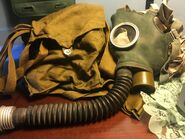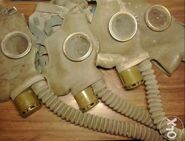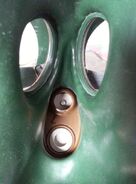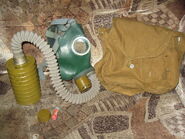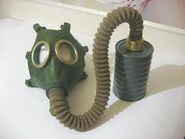(moved GP-4 info here) Tag: Visual edit |
|
(No difference)
| |
Revision as of 18:01, 7 September 2019
The Soviet GP-4 is a gas mask issued to Civil Defense and civilians in the Soviet Union.
Overview
The Soviet GP-4 is another mask in the Soviet GP series. Like all other masks in the GP series, it has a simple inlet and exhale valve system along with eye lenses encapsulated in metal to keep it on the mask. The mask itself has a green rubber face-piece with straps of a lighter tint of green. The mask has flat, glass eye lenses with a common metal band found on the GP-5 and GP-6, but was abolished with the GP-7 and future models. The metal band is very interesting. It is round with a few bands going downward and it commonly has a mesh of some sort beneath. This mesh, however, isn't found on all of the GP-4's.
Production of the GP-4u started in 1955 and ended in 1974. The face piece's designation is M49 and it is issued with a "Coffee Can" type filter and is designated GP-4u, it comes in either grey or brown; the common colors for coffee can type filters. Where the inlet valve is found is an irremovable hose kept in place by a darker grey band. The exhale valve is in a metal assembly, similar to the PDF-D but with a slight tint of tan. Because of the mask's simplistic design, it does toll the wearer by fogging up very easily as it has only a very simple inlet and exhale valve. Like other Cold War Era GP series masks, it comes with a green haversack with several pockets and one button.
GP-4u
The GP-4 and the GP-4u differ only in the hose attached to them: the GP-4 has a short, black hose, while the GP-4u has a longer, stockinette covered hose.
Popular Culture
In the video game series S.T.A.L.K.E.R a mutated creature called a Snork can be seen wearing a GP-4 in a helmet-type design.
Trivia
- GP-4's can create a "buzzing" noise, which is similar to snoring if used without a filter. This most likely has to do with the design of the exhale valve, which might vibrate when the airflow is much higher or the air resistance is much lower than when a filter is mounted onto the hose. It could also possibly be a quirk that develops with age, as the masks were made from the 1950s to the 1970s.

